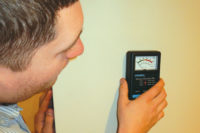
So where do you write down all your readings? I mean, you do take readings on every job, right? Besides just being foolish, having poor or no paperwork means you did not perform the task allotted.
You would be unable to prove in mitigation or in the courtroom that a successful drying project was completed. You probably would not get your full payment, and what if a mold claim was to develop soon after? You might find out what your own insurance policy limits are on liability and pollution insurance! For the minimal documentation required on each water damage restoration project, please refer to the IICRC S500 3rd Edition, section 8 and chapter 10.
The questions “Is it dry?” and “Is it drying?” can only be determined by our IMDs, or “Instruments of Moisture Detection.” They sound powerful, but none of them, including the old “Hand-O-Meter” which many profess to possess, detect moisture directly. All of our instruments use some form of mechanical measurement of weight, density, electrical resistance or temperature of the material in question, and then interpret these readings and present them on a chart, scale or a graphic image. Let’s look at a few of the most popular types available.

Invasive Meters
These units generally use electrical resistance between the two pins to interpret a reading on our percent wood moisture content by weight (a.k.a. Wood Moisture Equivalent) or qualitative (relative) scales (always indicate what scale you are using and stay with it). The more current that is passing between the pins, the higher the reading on the meter’s scale. So keep the pins clean and batteries fresh, or a lower-than-designed current may pass, causing you to have artificially low readings (false dry). This conductance is also why sill plates consisting of pressure treated lumber often read higher than the plywood subfloor or studs, due to their increased level of copper in the treatment process.These meters are very flexible. They can be used with insulated probes for moisture readings of insulation in walls or wood at various depths in flooring. Some manufacturers provide extension cables, and their probes can be mounted on telescoping and pivoting painters’ poles for reaching high ceilings or reducing back bending along the base in a large commercial project. You can use screws and nails to extend your reach like I and many others do, but make sure they are stainless, and talk to your meter provider about any corrections for continuity. Unless you have a meter with adjustable material temperature capability, you need to use a correction table for low or high temperatures on wood for an accurate reading. WME stands for Wood Moisture Equivalent.
Drywall is usually dry in the range of 0.2-0.5% moisture content by weight, and may be measured on this scale, but it must be noted WME. Meters with adjustable material temperature capabilities, like the Delmhorst Navigator Pro, will have multiple construction materials in their database.

Non-Invasive Meters
These meters leave no holes because they use either radio waves or capacitance for their interpretation. They display readings ranging from 0-100, 1-300, 200-300, etc. depending on meter brand and model. Again, this is why every meter model must have its own dry standard for the construction materials in your area, and why you always need to indicate which meter and scale you are using on your paperwork.The average non-invasive meters are usually limited to reading depths of 0.75” to 1” and cannot read through air. Items like wood subfloors beneath thicker floors, e.g. hardwood flooring or ceramic tile and cement board, cannot be accurately determined by the average non-invasive meter.
When getting a high reading on wood subfloors below vinyl flooring, let the vinyl floor dry for a day then measure again. Sometimes a thin film of moisture is present even after towel drying, so the meter gives you a high reading which leads you to believe the subfloor is wet. So confirm the subfloor is still wet the next day before removing the vinyl to dry the subfloor. You will save many more floors this way.

IR Cameras
The newest and truly the coolest meters to come in to our industry is the thermal imaging camera. This device allows us to see temperatures like Predator can but, just like we learn in Predator 2, seeing temperature does not by itself win the battle!When taught to use this camera properly, we can look for and usually find the temperature or heat signature of water. Whether looking for warm spots after sunset in a roof leak, or looking for the signature cooling affect of water evaporating off the surface of a material, a trained eye is required for this tool to reach its full potential.
False positives like the photo of steel studs in an exterior wall are annoying. False negatives, like a wet material that is not seeing evaporation due to vapor retarder on the surface, are potentially disastrous if overlooked. Always double check suspicious readings and never use just an IR camera for drying completion documentation.
The latest time-saving feature today’s cameras are incorporating is capturing moisture content and atmospheric readings and recording them on the digital image. These readings can be recorded via Bluetooth between the camera and a thermo-hygrometer moisture meter; FLIR/Extec is one company whose equipment has this capability. Just make sure you download your images because, as with any digital tracking system, loss of data can occur.
As always, the last and best word here is training; courses on equipment operation are offered by manufacturers, and there are many excellent instructors out in the industry well versed in a number of different technologies. Ask your supplier for their recommendation and begin boosting your moisture measurement I.Q. today!
Author’s Note:I hoped you liked, but did not record, the temperatures we talked about in the last article! Although one has to agree that a building would dry very fast at 400F and even faster as it burned at 950F, that article would make a whole lot more sense if those temperatures had read 40F and 95F, respectively. Funny what can happen when innocent superscripts – °, as in 40°F – are accidentally reformatted as “0” in the editing process, isn’t it? Thanks for reading!


Report Abusive Comment